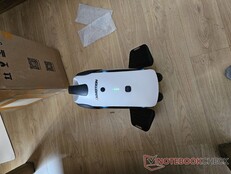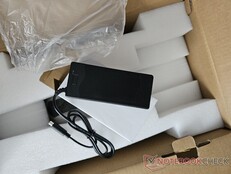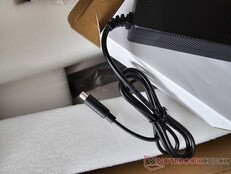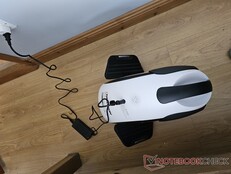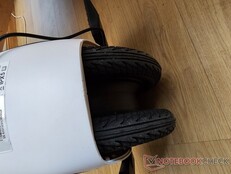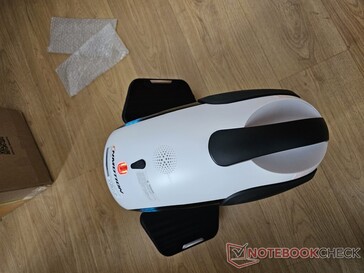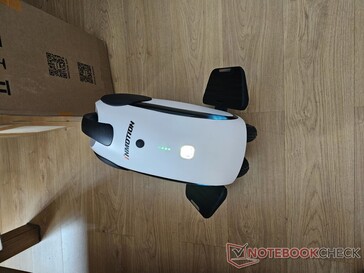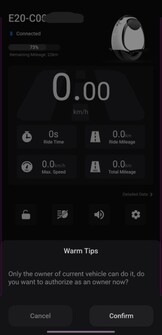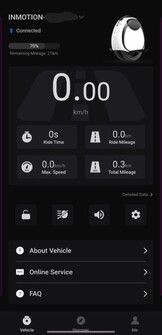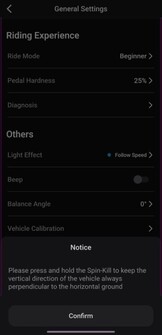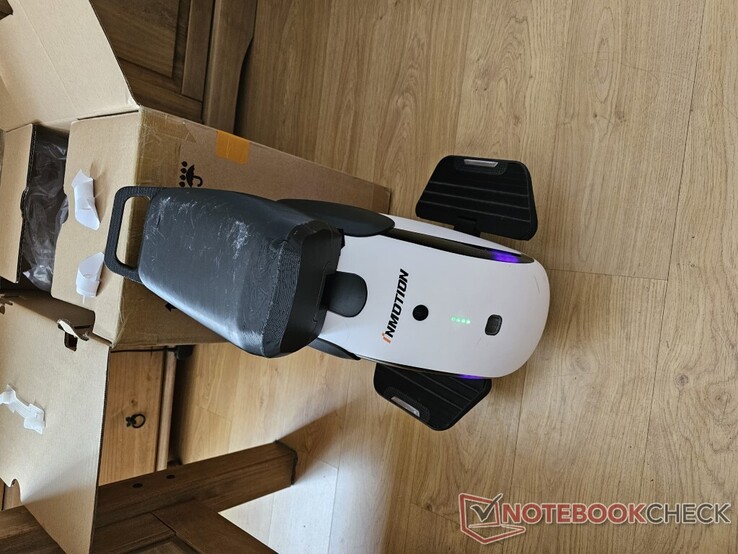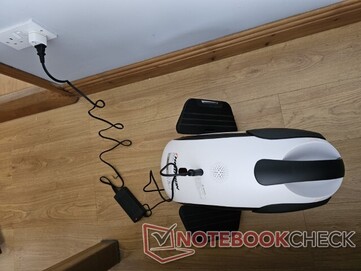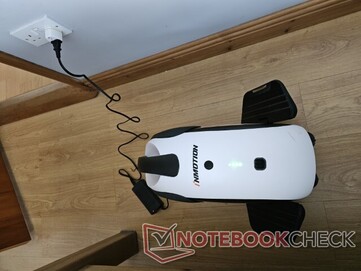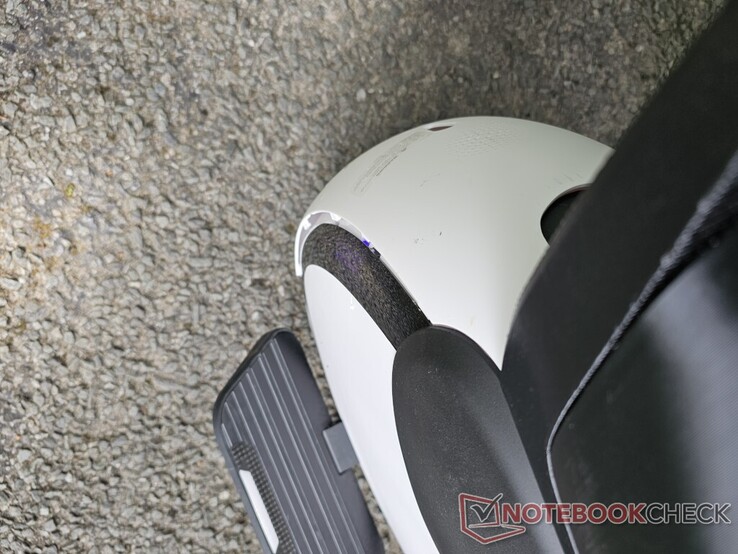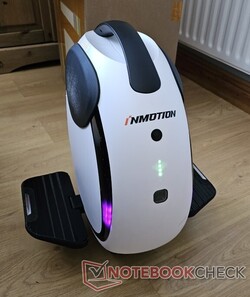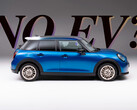INMOTION E20: Testing the world’s "easiest-to-learn" electric unicycle
INMOTION typically pitches its "e-wheels" or EUCs at the adult and/or enthusiast market; however, the E20 is pitched as a profoundly beginner-friendly product. It is also family-oriented, boasting the world's easiest learning curve of its class with its "self-balancing" nature.
Nevertheless, it is also rated to achieve a top speed of 20 miles per hour (mph; nearly as fast as most e-bikes) thanks to a 450W/900W peak motor. Can one really learn how to ride one in as little as 3 minutes, as the OEM asserts?
First Impressions
Despite that onerous prospect, the E20 has a reasonably inoffensive appeal out of the box, arriving well-packed with a curved plastic shell finished in white that covers most of the wheels and internals, as opposed to the more exposed, functional look of other INMOTION EUCs. Its minimalist design packs a handle in black that also curves around the top, and pedals that can fold up to keep it compact in storage.
On the back, there is a rubber charging-port cover that also neatly acts as a stand to protect the E20 from damage when not in use.
A circular grille is found above, which is for the vehicle's inbuilt speaker.
The E20 also has a dual sweep of accent lights along its wheel-arches. They are blue out of the box, although the color can be changed in its app (more on that later).
The E20 also comes with a transformer-type charger, a choice of EU or US (but not Republic of Ireland/UK, unfortunately) socket adapters and a user guide which, among other things, advises the owner to use protective equipment with the vehicle.
Design
A closer look at the E20 reveals that it is (as the online EUC community was quick to point out) technically not an EUC. It actually has 2 wheels placed side by side, so as to boost its rider safety and stability hype.
Then again, the extra wheel does have a number of advantages, which is to make it relatively easy to learn to mount the E20 and get going. The vehicle's manual and quick-start guide recommends measures such as using the assistance of a wall (or a person) at first, although it was not too long until I was able to get one foot on it and then the other in open space.
It might indeed be part of what makes it so relatively easy to stand up on and pilot forward and backward, although I also frankly think it might restrict the ability to swerve suddenly, especially at low speeds and also possibly for someone of my height. I get the impression (while consuming EUC content in the course of research) that a true one-wheeler would be more flexible, albeit more difficult and harder to master.
In addition, it is still possible to overbalance, as the E20's dual wheel can really punish you if you lean over too far in one direction. In that case, it's all too tempting to jump off and leave it to its own incessantly beeping devices (see below).
It might also be what helps the E20 get up to speed, although a lot of flat, open space is recommended for that.
Then again, the dual wheels don't seem to help the vehicle on terrain other than indoor flooring or concrete, to be honest: it seems completely unsuited to gravel or grass, not the least because the 14-inch tires are inflatable and prone to snagging on things.
Safety Features
The E20 is profoundly safety-centric in its feature set, and is thus rated to come with a headlight and red rear light, both of which work as advertised and are quite bright.
INMOTION also underpins safety by packing the E20 with tip-detection sensors, which immediately cause loud, obtrusive beeping noises on the second it goes over on its side. Its accent lights also flash red, neither of which stop until you put the device back upright and double-press the power button to get it to balance itself again.
Finally, the E20 also has leg-pads just below the handle, which are for comfort more than safety.
App & features
The E20 requires connection to the INMOTION app (for iOS or Android) to initialize properly. It also allows the user to register themselves as the vehicle's owner, connect to the device and control some of its functions.
It is, for example, the only way to switch between the Beginner, Normal and Sport modes that determine how fast the vehicle can go.
The homescreen has a fairly good, clear lay-out, with 4 'performance' cards that show useful metrics such as ride time and max speed on first boot, but can be customized and augmented with a range of alternative cards that include torque, average speed and battery consumption.
It is also reasonably clear and concise (in English, at least), with few strange word choices or misnomers (although "Warm" Tips is a new one, as is "I See" to acknowledge notifications).
Finally, it has a dark theme by default.
I like the app, which has a lot of advantages such as a back-up control for the lights. It can't actually activate the device - although it doesn't shut down when it loses connection, which is a relief. It has also had no major software malfunctions thus far. Access to the settings is denied unless the E20 is connected, however.
Performance
In keeping with the constant safety trope, the E20 comes in the aforementioned low-speed Beginner Mode out of the box. It does indeed help build confidence when learning to ride the vehicle, although I found it easier to keep balance at higher speeds (as with my e-bike), not to mention make any kind of turning maneuver.
On that note, I have had a lot of trouble verifying its rated top speed thus far, as the vehicle is honestly only suitable for perfectly flat concrete, wobbling in a worrying manner even on the best and flattest roads around here (of which there are not many; welcome to Ireland). I could also propel it up the gentlest of slopes, which makes me doubt the up-to-15° climbing spec.
The E20 does deliver its anti-crash features very well, ensuring it will be heard if, for example, it just happens to roll into a wall or a verge by itself.
Going backward too fast or gathering any speed at all in Beginner Mode also results in more admonditory beeping.
The E20 can also be used to stream mobile device audio. It connects via Bluetooth like many other external wireless speakers, and seems to have a good range - better than that for the actual INMOTION app, although those results might depend on the smartphone used.
It is also surprisingly loud and clear, except at its highest volume levels - however, it is also marred by the whistling and white noise that the machine also produces, the pitch and tone of which honestly seems to be influenced by the frequency of the RGB lighting. Combined with the noise of the motor, it is detrimental to the overall audio experience.
Toward the end of its testing period, INMOTION also sent a seat made to fit the E20.
It is made of a vaguely leather-like material - which was a little scuffed and torn up, although that might be due to transit issues or simply that it is a pre-production review-unit product: I'd hope retail-grade units would not turn up like this.
It is not a conventional unicycle seat in that it is solid and somewhat cushioned, with a handle toward the back.
It is installed on the E20 via a system of Velcro strips on its underside, which don't really seem secure enough and also affect the look of the vehicle thereafter, as the bottom strip is also affixed with pre-applied adhesive.
It adds some height to the E20 when installed, and creates an even easier way to mount it.
Then again, it also affects rider balance (in my experience), and causes it to list backward by itself due to the additional weight. I needed to calibrate the device again to fix that issue.
The E20 charges like many standard e-bikes via its 100-240V ~60Hz power supply, which does not seem to heat up much during use.
Overall, I have had fun with this innovative little vehicle - so long as I don't ask anything too challenging of it. I particularly like the design, particularly the pedals, which are sturdy (like little running boards), always feel reliable and can be adjusted in terms of "hardness" (the amount of pressure needed to change direction) in the app.
Then again, I have had the E20 for testing for about 2 weeks now, and still find myself restricted to the level of whizzing around the house with it. The "3-minute" learning curve holds up - albeit only when it's applied to the process of actually learning to get and stay on the thing, and to do basic things such as going back and forth (done by leaning in the appropriate direction).
It was indeed not too long before I felt I was practically doing that by using the Force - however, anything more complicated, such as staying balanced while getting up to speed, does take a bit more time - and not merely because its safety comes at the cost of advanced mobility.
Admittedly, those observations could be influenced by my overall athletic skills and ability (which I've never found satisfactory); nevertheless, it's plain that if I want to get to YourAubsome-type levels any time soon, I might need a different EUC.
The IP5X-rated E20 also seems durable enough thanks to its shell: even the worst accident it has had thus far resulted in not much more than part of the outer shell popping out of its clips, and I was able to push it back into place again anyway.
Then again, the outer plastic has acquired a considerable number of small, yet indelible, scratches and nicks - although that was probably inevitable as I went about testing its well-hyped safety features with all the compassion of a Boston Dynamics engineer with a stick. They might affect its re-sale value in the long term, though.
Pros
+ Beginner-friendly build and design; no assembly required
+ Self-balancing function is robust and reliable
+ Long battery life
+ Motor delivers speeds as advertised
+ App is user-friendly, well-designed and informative
+ RGB
Cons
– Maneuverability could be better
– Noisy, even when not in motion
– Inbuilt speaker is less usable at high volume
– Less usable on rough terrain
Verdict
Ultimately, I find that the E20 might, as the OEM suggests, be best suited to kids - ideally with parents that can monitor them closely while doing so. On that note, protective equipment such as knee- and elbow-pads as well as a helmet are a must when using this machine. Then again, I have yet to incur anything like a severe injury as a result of riding it - which is fun, although I do not think I would replace my e-bike with it.
Ironically, I would prefer to use it without the seat. It seems unnecessary and just too much of a crutch for an adult rider to be honest, except perhaps on an extremely prolonged riding session.
On that note, INMOTION estimates that you should get ~30 kilometers (~19 miles) per charge, which seems to hold up - it takes days to kill the battery, which can also be monitored in the app.
Price and availability
INMOTION seems to have ditched earlier plans to put the E20 on Kickstarter; instead, the first-gen entry-level EUC will be available directly from the OEM for $399 from now.
Transparency
The selection of devices to be reviewed is made by our editorial team. The test sample was provided to the author as a loan by the manufacturer or retailer for the purpose of this review. The lender had no influence on this review, nor did the manufacturer receive a copy of this review before publication. There was no obligation to publish this review. As an independent media company, Notebookcheck is not subjected to the authority of manufacturers, retailers or publishers.
This is how Notebookcheck is testing
Every year, Notebookcheck independently reviews hundreds of laptops and smartphones using standardized procedures to ensure that all results are comparable. We have continuously developed our test methods for around 20 years and set industry standards in the process. In our test labs, high-quality measuring equipment is utilized by experienced technicians and editors. These tests involve a multi-stage validation process. Our complex rating system is based on hundreds of well-founded measurements and benchmarks, which maintains objectivity. Further information on our test methods can be found here.







